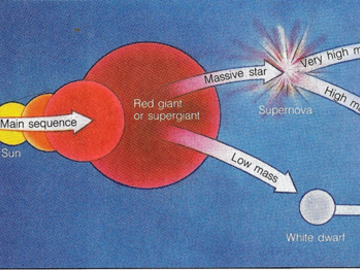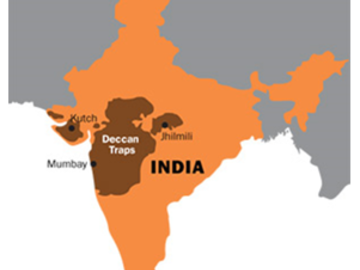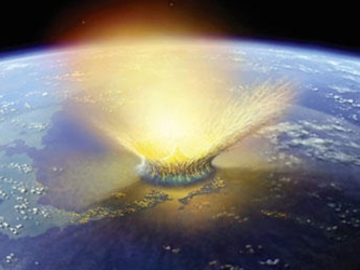
The Dinosaur Extinction
Evidence informing theories, or theory informing evidence?
In this case study...
We explore the assembly of evidence and the development of theories to explain the mechanism for K-Pg extinction
Case study by: Emily Hurst
Intro to the K-Pg extinction
Geological records indicate that some 65 million years ago the last of the dinosaurs along with almost every other large vertebrate on the earth went extinct. This extinction event marked the end of the Cretaceous period and was devastating to flora and fauna, big and small. Planktonic primary producers, the base and essential component to the thriving Cretaceous food web were obliterated from the oceans. These drastic changes were not isolated to any one region and the effects were felt across the globe. This mass extinction event imprinted in the geological record is known as the Cretaceous – Paleogene (previously the Cretaceous–Tertiary, or K–T) extinction. The K-Pg extinction, though punctuated with the loss of both species and abundance, created an ecological playing field in which new species could enter freshly vacant ecological niches and evolve into many of the species that inhabit the globe today. In a sense, the K-Pg extinction allowed evolution of mammals, birds and other animals that are similar to what is present today. While we can be confident that the K-Pg extinction did occur, its cause had been a question more difficult to discern. We know that dinosaurs existed and then died off: But what killed them?
The idea of mass extinction was developed by Georges Cuvier (1769-1832), who first noticed this pattern of large populations of animals (recorded as fossils) that seemed to reach a point in the stratigraphic record and then just cease to exist. He posited some sweeping, global catastrophic event that would have been responsible for such decimation of life forms at once. This idea, however, did not fit the uniformitarian ideal of slow and steady changes put forth by Charles Lyell. Many paleontologists attempted to solve the puzzle of the strange deaths, especially for the dinosaurs. They were the most dominant life form living at the time. Understanding what killed them off became a very popular pursuit for many. As a result of the many trying to determine the cause of death of the dinosaurs, there were many suggestions of possibilities.
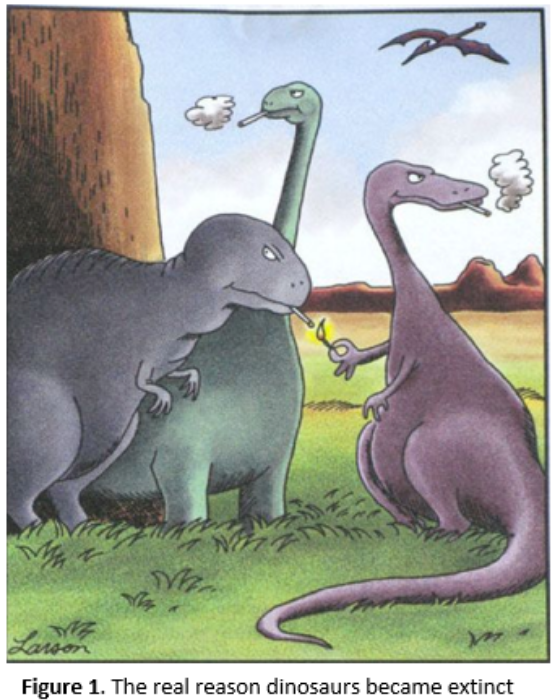
Just some of these included were high levels of carbon dioxide in the atmosphere, and low levels of carbon dioxide in the atmosphere, extensive volcanism, the development of cataracts in the dinosaurs causing them to go blind, a changing climate, causing it to be too wet, or too dry, or too warm, or too cold. Some hypothesized a nearby supernova explosion causing radiation to rain down on the surface, killing the dinosaurs. Other ideas included thinning egg shells, epidemics of disease, changes in floral types, an impact with a large bolide (meteor, asteroid, or comet), mental disorders, changes in the oceans, overpopulation, uranium poisoning, and decrease in sexual activity (Figure 1).
Think question: Pick one or two of the above possible causes for dinosaur extinction and try to develop a way to test that hypothesis. What kind of data would you be looking for? Where would you go to look for it? What would you need to find to support your hypothesis?
Walter Alvarez on a thin layer of clay
Fast forward to the mid 1970’s. American geologist Walter Alvarez (b. 1940) is working for an oil company in the Apennine mountain range in Italy near the town of Gubbio. He was there studying magnetic reversals in the Earth’s crust and focused on an area that contained a large continuous outcropping of limestone. This limestone held fossilized in its crust tiny shelled creatures called foraminifera, or forams for short (Figure 2). These forams were found throughout the limestone in the Gubbio area except for in a thin layer of clay between two more substantial limestone layers that had been laid down and compressed over time. Upon close inspection of this centimeter-thick clay layer, Walter observes that no forams are present in any of the clay samples taken from various locations along the mountain range. Walter becomes intrigued by this loss of forams evident in the clay layer (Figure 3). He wonders why the layer was there, what had caused it, and how much geological time did it represent?
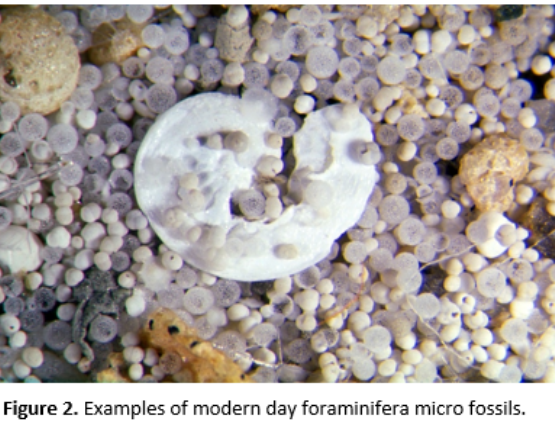
Walter and his colleague Bill Lowrie, now motivated by a personal interest in the foram-free clay deposition continue to study the Gubbio site. Their first course of action is to comprehend how the reversals in the Earth’s magnetic field that they had been studying initially could be used along with the fossil record to compose a time scale of the Earth’s history in this area. Walter and Bill determine that marked differences in populations of forams present in the limestone on either side of the clay indicate the transition from Cretaceous period to Paleogene period. The clay layer, which was devoid of observable lifeforms, divided the Cretaceous form the Paleogene period and was representative of the K-Pg boundary.
Armed with knowledge of what time frames were represented in the ancient layers of rock, the colleagues are determined to get to the bottom of what caused the change from Cretaceous foram species to Paleogene foram species and what the complete lack of forams in the K-T boundary clay layer meant (Carroll 2016 pg 2-3). Walter wonders: “How much time did it take for the clay K-Pg boundary layer to form?"
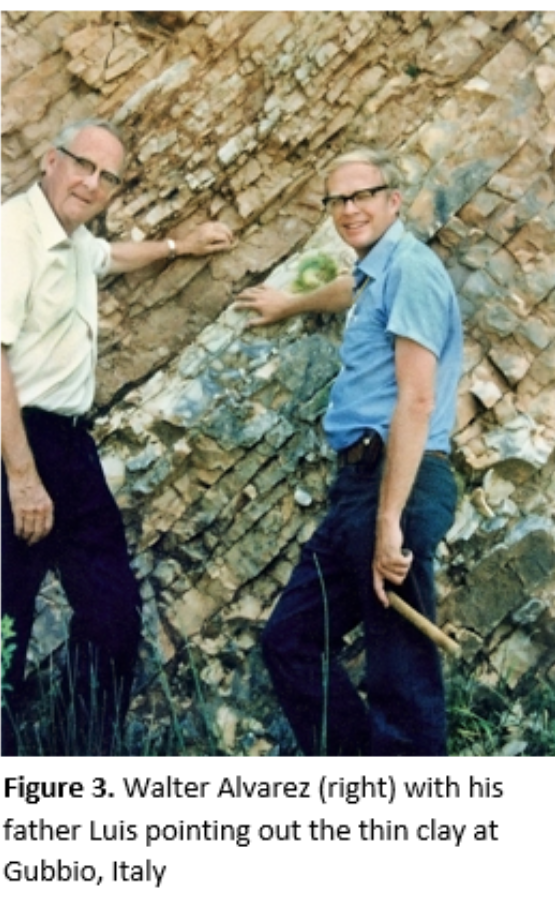
How much time did it take for the clay K-Pg boundary layer to form?
- Walter Alvarez
Like father, like son
Walter, a competent academic in his own right, enlists the help of his father Luis Alvarez (1911-1988). Luis was a noted physicist, who developed radar systems during WWII to help planes land in poor visibility. He was later recruited by the secretive Manhattan project to develop nuclear weapons. After the war, He returned to academia, and in 1968 he went on to win a Nobel Prize in Physics. Walter, while working at Berkeley in the geology department, shows his father a small cross-section of the Gubbio K-Pg boundary clay and describes to him what he had observed throughout the various locations he had sampled. Walter asks Luis about how one might determine the time span over which the K-Pg clay boundary layer might have formed.
Think question: Imagine you are Luis Alvarez. How might you determine the time it took to deposit the K-Pg clay layer?
Luis suggests that they measure the abundance of the element, beryllium-10 in the K-Pg clay layer as this radio-active isotope is constantly forming in the atmosphere, and as a result, settles to the surface in a constant and predictable concentration. Therefore, if there is a higher abundance of beryllium-10 in sedimentary rock, that would indicate a longer span of time. With this in mind, the Alvarez’s seek the assistance of another physicist, Richard Muller, to help with the beryllium-10 measurements. They reason that determining the abundance of beryllium-10 in the clay layer and then correcting for how much would have been lost through the radioactive decay process, would give them a good idea of how long it took for the clay layer to be deposited (Berkeley 2007). The team was keen to get their measurements completed so that a time-frame could be determined. Unfortunately, they realized that documented half-life of beryllium-10 was incorrect as published. The actual decay rate was shorter than what was previously thought, so in the 65 million years since the K-Pg extinction occurred, all the beryllium-10 will have decayed into a different isotope rendering it useless as an indicator of time passed during the deposition of the clay layer.
And so, back to the drawing table for the Alvarez’s. Following the same logic as the Berylium-10 idea, Luis recalls that Platinum group elements are 10,000 times more abundant in meteorites than in the Earth’s crust. He knows that the amount entering and settling out of the atmosphere due to the dust created from meteorites burning up in the atmosphere should stay relatively constant over time. In this case, the amount of these elements in the clay layer could potentially be used as a measure for the amount of time that had passed during the deposition of the K-Pg clay layer. Luis suspects that if the clay had been deposited over thousands of years, that the scarce platinum metals would be detectable, but that if the clay layer formed quickly, the platinum metals would be undetectable. They choose to measure iridium, a platinum group metal, as it is easier to detect than platinum itself. Fortunately, Luis also knows of two physicists: Frank Asaro and Helen Michel of the Berkeley Radiation Laboratory, that have the knowledge and equipment needed to perform the analysis.
Walter, through Luis’s connection with the Berkley radiation group, gives Frank and Helen some of the samples samples from the Gubbio site containing the K-Pg clay layer. As the lab is very busy and this is really only a side project for Frank and Helen, the samples take months to process. Also, the techniques used are time consuming and equipment repairs slow the analysis even more. It is not until nine months after Walter had handed over the samples that Luis let Walter know that Frank wants to discuss his results. Based on expected levels of deposition, they suspect that iridium levels would be around 0.1 parts per billion (ppb). However, Frank and Helen determine through their analysis that there is actually 3ppb of iridium in the clay layer, an astounding 30 times more than expected based on the amounts found throughout the layers of limestone in the Cretaceous and Tertiary layers.
Think question: The results of the analysis on the clay layer showed that the concentration of iridium was 30 times the expected value. Knowing what a higher concentration in the sample should mean for the time it takes to deposit the clay (higher concentration correlates to a longer time), and knowing at least one source of iridium (meteorites from space). What can you say about these findings? How might you go about trying to find evidence to support your claims?
Think question: What are some other questions that this anomaly raises for you?
Were the high levels of iridium something that was anomalous to the clay layer in Gubbio or was it widespread? To answer this question, they need to analyze samples of the same age from other sites. Walter sets out to examine the geological structures of Stevns Klint formation near Copenhagen, Denmark. This area is known in the geological community to have a highly visible fossil rich coastal cliff spanning the Cretaceous and Paleogene periods. The chalky white cliff also bears a wide range of fossil types, but upon inspection, Walter observes that the clay layer exists at this site as well. In this location, it emitts a sulfuric smell and contains only fish bones which was in sharp contrast to the fossils above and below the layer. Walter collects more samples and sends them on to Frank and Helen for analysis. This time around, the level of iridium in the Stevns Klint clay layer is 160 times higher than the surrounding rock layers. It begins to seem to Walter that a trend could be emerging, but more testing will be required before drawing any conclusions.
Around the same time that Walter and his colleagues are exploring the Gubbio limestone, A Dutch geologist by the name of Jan Smit is working in Caravaca on the southeast coast of Spain. He, like Walter, also observes changes in the foram patterns in the rocks near the K-Pg boundary in his location. Walter contacts Jan and urges him to check the iridium levels in the samples he has collected in Caravaca. Once the tests are performed Jan lets Walter know that the levels of iridium were in fact elevated. Furthermore, samples of the K-Pg boundary from New Zealand, where he is also doing a separate investigation, also show iridium levels that were 20 times higher than the surrounding rock. At this point, Walter and the others involved become convinced that there was something going on with the K-Pg boundary and that whatever happened, it was a global in extent, rather than regional event.
Think question: The levels of iridium were much higher in the clay layer than in the surrounding rock. What could have caused this massive amount of iridium to be deposited in this layer?
K-T extinction theories explored
K-T extinction theories explored
By taking this new data, and the assumption of a global cause for the elevated iridium levels, three possible causes come into view: Supernova explosion, massive volcanism, and an impact with a large extra-terrestrial object (bolide).
1. Supernova
About a decade prior to the discovery of the high iridium levels in the K-Pg clay layer by Walter Alvarez, physicist Wallace Tucker and paleontologist Dale Russell came up with the hypothesis that radiation given off by a supernova was the likely cause the K-T extinction. Supernovas, the massive explosion marking the death of very large stars, are extremely energetic and give off large amounts of heavy metals including iridium which would shower the earth and deposit on its surface in concentration much higher than normal (Figure 4).
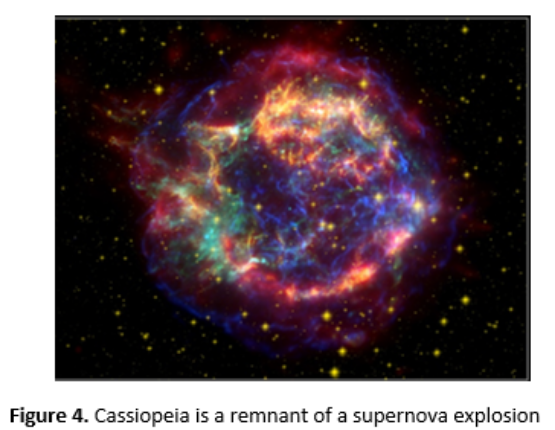
2. Massive volcanism
Just like iridium is in high concentrations in the center of meteorites, so is it much higher below the surface lithosphere of earth. To bring large amounts of such an element to the surface from the mantle would require volcanic eruptions of a very large magnitude (Figure 5). Another theory suggested that during the time of the K-Pg extinction massive volcanic eruptions took place in India near modern day Mumbai which produced what we call today the Deccan Traps.
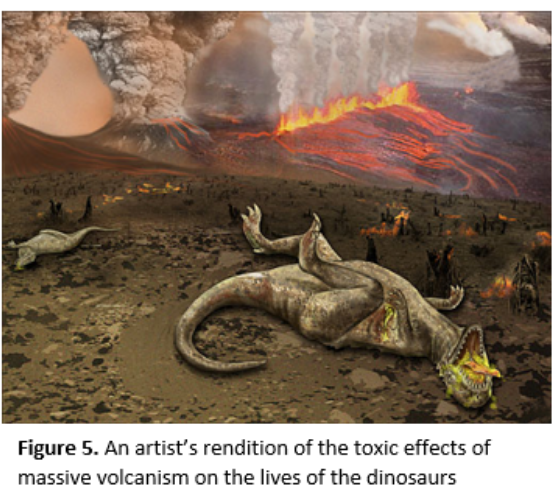
The Deccan Traps is composed of many layers of solidified flood basalt (hardened lava flows) that is in some areas 2000 meters thick. These eruptions would have been long standing and would have pumped huge amounts of carbon dioxide into the atmosphere greatly disrupting the balance of the Earth’s ecosystem and the flow of the carbon cycle (McLean 1995).
Walter and Luis feel strongly that the iridium came from space. The levels of iridium in space dust seems to them to mesh well with the levels they have observed and could seemingly explain why the spike in iridium was observed on a global scale. Tapping into his physicist knowledge base, Luis knows that an exploding star would give off a myriad of other heavy metals beyond iridium. This reality gives the scientists a way to cross reference the components of the K-Pg layer with what would be spread on the Earth's crust if a nearby star exploded. They do not want a repeat of what happened with beryllium-10 when they were trying to create a timescale of the deposition of the clay layer so Luis decided that they should test for plutonium-244 which had a robust half-life of 75 million years. This half-life would ensure that if plutonium was given off by a supernova along with iridium, that it would not have fully decayed and could be measured (Carroll 2016 page 9). Frank and Helen once again perform the tests, this time for plutonium-244. To the team's delight, the tests came back positive for the isotope in question.
Think question: Now you have two possible explanations for the iridium anomaly in the K-Pg clay: a supernova explosion and massive volcanism. Other observations include plutonium-244, supporting the supernova explosion and the Deccan Traps supporting the massive volcanism. Devise a way to distinguish one from the other. In other words, how might you try to see which explanation, supernova or volcanism, is the most likely explanation for the observations.
However, their excitement is short-lived as upon replicating the analysis. They discover that there is actually no plutonium-244 in the clay sample. The original readings had been attributed to cross-contamination for another lab in the vicinity. It is back to the drawing board once again (Berkeley 2007).
3. Another extraterrestrial option
Luis ponders what could have caused the K-Pg extinction now that a supernova seemed exceedingly unlikely. Was it a volcanic eruption that blotted out the sun and prevented photosynthesis? Perhaps the iridium somehow made its way from Jupiter? It was then that an astronomer from Berkeley, Chris McKee, suggested that an asteroid could have caused the K-Pg extinction (Figure 6). This seemed unlikely to Luis as well. An asteroid would cause a tsunami but he couldn't see how this would kill off the dinosaurs and a multitude of other species big and small. Still, this was an avenue worth exploring and it did fit with their hypothesis that the iridium was from space.
Think question: Now enters a new theory for development with the data. Aside for iridium, what other data might you like to observe to support this hypothesis?
Class activity: Debate possible explanations of dinosaur extinction
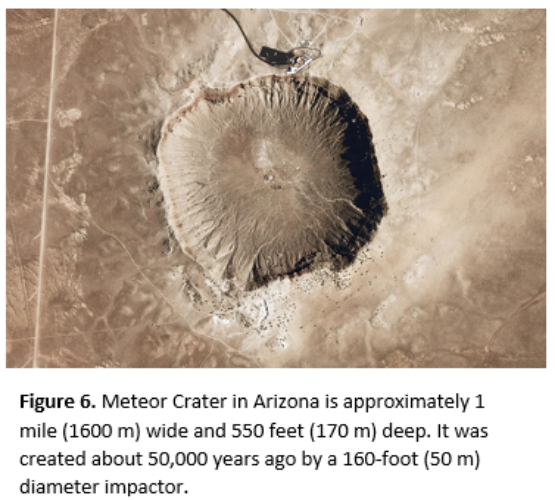
Please proceed to activity
The Alvarez's set out collect evidence in support of this new K-Pg extinction theory. They hypothesized that huge quantities of debris for the impact would be projected into the Earth's atmosphere, akin to what would occur from a massive volcanic eruption but at an even more prolific scale. This dust would prevent the sun's rays from reaching the primary producers thus preventing photosynthesis. This theory alone did not have enough explanatory power to set it apart for the hypothesis that photosynthesis could be inhibited from widespread, longstanding volcanic eruptions.
Think question: If an asteroid of substantial size did hit the Earth 66 million years ago, there would undoubtedly be evidence of what occurred. But what kind of evidence would be left after all these years?
One of Luis' first thoughts when considering the asteroid impact hypothesis, is that there would be a large tsunami (very large long wavelength wave in the ocean). He thought that such a tsunami would cause massive disruptions to the ocean floor and the stirred-up debris would be spread out over a large area in the water and on land. A huge crater would also support the impact hypothesis. Luis estimated, based on his calculations that the asteroid would have been roughly 10 km in diameter and would have been traveling towards Earth at a staggering 50,000 miles per hour (Carroll 2016). This asteroid would hit the Earth with such force that debris from the impact site would be ejected across the surface of the Earth creating a layer of fine material like what they have been observing in various parts of the world, what will become known as the K-Pg layer. The heat created by the impact would have also melted rock into glass and produced shockwaves that would have deformed rocks into "shocked quartz" (Figure 7) (Berkeley 2007). The impact scenario would have been a catastrophe by any definition.
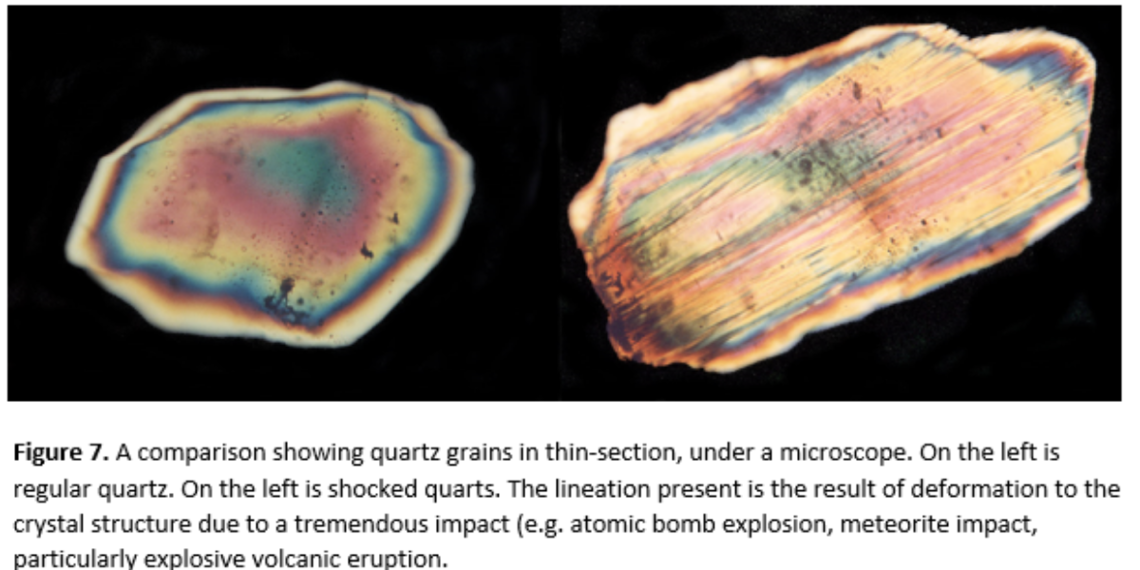
Luis, Walter, Frank and Helen feel that the hypothesis fit the observations best. In June of 1980, the team's findings are published in Science. The paper was entitled: Extraterrestrial Cause for Cretaceous-Tertiary[1] Extinction. Their take on the cause of the K-Pg extinction is met with mixed reviews. It went against the idea that mass extinctions were caused by gradual processes over millions of years, while their hypothesis suggested that the die off was relatively swift. Also, the impact hypothesis was missing a key piece of evidence: The crater left by the asteroid that supposedly caused the K-Pg extinction.
Think question: Does the absence of the crater as evidence for a cataclysmic impact of a meteor automatically make this hypothesis invalid? Support your answer.
A search for the crater
Even if it did exist, the crater could be exceedingly difficult to find. The majority of the Earth's surface is covered by the ocean and its bottom is widely uncharted. For years scientists try to figure out where the asteroid could have hit, but no one is able to find a crater of the right dimensions and age to suit the hypothesis. Walter surmises that the asteroid hit the ocean and that the chances of finding the crater are slim. Then in the mid 1980's, tektites which are small pieces of glass were found in a river in Texas which empties into the Gulf of Mexico (Carroll 2016). These tektites could possibly come from an impact site. Also, in this same riverbed, there are sandy deposits which were almost certainly left from a massive tsunami. About this time, Alan Hildebrand is working as a graduate student at the University of Arizona and decides to put his efforts toward finding the impact site.

Based on the river debris and tektites found near the Gulf of Mexico, he focusses on the Gulf and the Caribbean areas. In Haiti, Alan observes more tektites that were even larger than the ones found previously. He also observes shocked quartz; another possible sign of an impact. Alan and his supervisor think that they could be very close to where the asteroid impact occurred, potentially within a 1000 km of Haiti (Carroll 2016). Using information from a Mexican oil company regarding the terrain of the region, Hildebrand determines the crater site to be adjacent to the Mexican village of Chicxulub on the Yucatan Peninsula, approximately a half-mile below the surface.
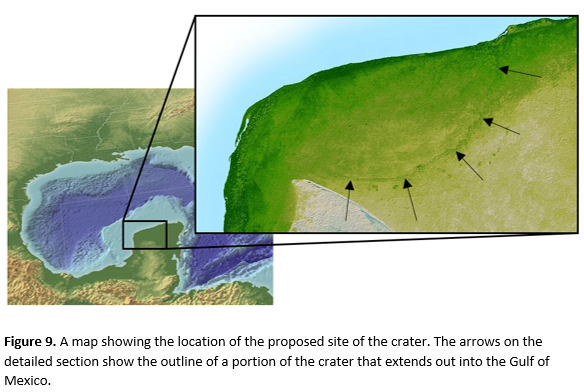
A main question is if the crater is the correct age to be a remnant of a K-Pg impact. This is a tricky task, as the crater had been buried over time. Thankfully, the Mexican oil company that had provided the information about the crater initially, took core samples during their exploration for crude oil. Several samples are shipped to various laboratories for analysis. When the results come in, the labs had all come up with the same dates for the core samples: roughly 65 million years old. The crater site was formed at the same time as the beginning of the K-Pg extinction. The evidence had been found, and the impact theory buttressed by the physical site of impact.
Think question: Suppose the crater was never found. Could the impact hypothesis hold up as a viable theory?
Activities
A debate among the three main explanations for dinosaur extinction
Go through the evidence in groups and determine what may support each of the hypotheses. Refer to the images below and the teacher's notes for more information
Physicist Wallace Tucker and paleontologist Dale Russell proposed that a supernova at the end of the Cretaceous had caused the extinction of dinosaurs. Supernovas produce and project heavy elements and massive amounts of radiation.
Activity: Go through the evidence as a group and determine what may support the hypothesis that a supernova caused the K-Pg mass extinction event 65 million years ago. Once completed, add your proposed evidence to the list on the board.
Evidence
- High levels of the heavy metal Iridium found at the K-Pg boundary
- Shocked quartz which is formed by intense pressure
- Massive crater site dated to 65.5 million years ago
- Evidence of large amounts of sulfur present during the K-Pg extinction (there is a large supply of sulfur in rocks)
- Evidence for a massive climate shift from warmer to cooler
- Evidence for a large increase in atmospheric CO2
- Evidence for a massive reduction in photosynthesis (requires sunlight) and a breakdown of food webs needed to sustain life
- Evidence of massive lava flows beginning 250,000 prior to the K-Pg mass extinction
Suggests that a massive volcanic eruption in what is now India began about 250,000 years before the beginning of the K-Pg mass extinction. It is proposed that this long standing and widespread volcanism may have caused the extinction of the dinosaurs.
Activity: Go through the evidence as a group and determine what may support the hypothesis that volcanism caused the K-Pg mass extinction event 65 million years ago. Once completed, add your proposed evidence to the list on the board.
Evidence
- High levels of the heavy metal Iridium found at the K-Pg boundary
- Shocked quartz which is formed by intense pressure
- Massive crater site dated to 65.5 million years ago
- Evidence of large amounts of sulfur present during the K-Pg extinction (there is a large supply of sulfur in rocks)
- Evidence for a massive climate shift from warmer to cooler
- Evidence for a large increase in atmospheric CO2
- Evidence for a massive reduction in photosynthesis (requires sunlight) and a breakdown of food webs needed to sustain life
- Evidence of massive lava flows beginning 250,000 prior to the K-Pg mass extinction
This hypothesis proposes that an asteroid about 10 kilometers in diameter struck what is now the Yucatán peninsula in Mexico roughly 65 million years ago. It suggests that this impact was the primary cause of the K-Pg mass extinction event that killed the dinosaurs.
Activity: Go through the evidence as a group and determine what may support the hypothesis that an asteroid impact caused the K-Pg mass extinction event 65 million years ago. Once completed, add your proposed evidence to the list on the board.
Evidence
- High levels of the heavy metal Iridium found at the K-Pg boundary
- Shocked quartz which is formed by intense pressure
- Massive crater site dated to 65.5 million years ago
- Evidence of large amounts of sulfur present during the K-Pg extinction (there is a large supply of sulfur in rocks)
- Evidence for a massive climate shift from warmer to cooler
- Evidence for a large increase in atmospheric CO2
- Evidence for a massive reduction in photosynthesis (requires sunlight) and a breakdown of food webs needed to sustain life
- Evidence of massive lava flows beginning 250,000 prior to the K-Pg mass extinction
A debate among the three main explanations for dinosaur extinction
Split into three teams of scientists representing each of the three major ideas concerning the extinction of the dinosaurs (radiation from a supernova explosion, environmental impacts of massive volcanism, environmental impacts from meteor/asteroid impact). Each group should read a little background on their proposed explanation for dinosaur extinction. That background can be found here:
- Supernova explosion – http://www.nbcnews.com/id/3900550/ns/technology_and_science-space/t/theo.... WZ8vFXeGNyo
- Volcanism – HTTPS://WWW.WIRED.COM/2008/12/DECCANTRAPS/
- Impact - https://www.scientificamerican.com/article/asteroid-killed-dinosaurs/
- Each group should write down information that supports their hypothesis and why it supports their hypothesis.
- Each group should be aware of the evidence of the other two groups’ ideas and try to develop an argument against them. What are the problems with the other groups’ ideas? How does our group’s idea do a better job addressing the data? It would be worth it to make a table with columns for “evidence” and rows for each hypothesis and then check the boxes where evidence supports a particular hypothesis.
- Develop a plan that would help secure data that would support the group’s idea.
- Have a three-way debate where representatives from each group put forth the strengths of their idea while also highlighting the weaknesses of the other groups’ ideas.
- Let audience of the debate decide who has the strongest case.
Questions for the class after the conclusion of the debate and decision about the winner:
- Is it possible that there is another explanation for dinosaur extinction that is not presented here? Support your answer.
- Which hypothesis is what really happened? How do you know?
- Is there any way to test each of these hypotheses? If so, how? If not, why not?
- How did listening to the arguments of groups influence your thinking about your group’s idea, or your own understanding of how the dinosaurs went extinct?
- What are some of the difficulties of interpreting things that happened in the past?
References
Bibliography
- Berkeley, University of California Museum of Paleontology & Regents of the University of California. (2007). Asteroids and dinosaurs: Unexpected twists and an unfinished story. http://undsci.berkeley.edu/lessons/pdfs/alvarez_woflow.pdf . Accessed September 2016.
- Carroll, S.B., (2016). The day the Mesozoic died. Nautilus; 32Space. http://nautil.us/issue/32/space/the-day-the-mesozoic-died. Accessed September 2016.
- McLean, D. M., 1995, K-T transition greenhouse and embryogenesis dysfunction in the dinosaurian extinctions: Journal of Geological Education, v. 43, p. 517-528.
Image credits
- Top banner image: https://www.theguardian.com/science/2020/jun/29/dinosaurs-wiped-out-by-asteroid-not-volcanoes-researchers-say
- The real reason dinosaurs went extinct: http://scienceblog.cancerresearchuk.org/2007/09/26/cancer-did-not-cause-dinosaur-extinction/
- Foraminifer a micor fossils: By Hannes Grobe 20:52, 12 November 2006 (UTC), Alfred Wegener Institute for Polar and Marine Research, Bremerhaven, Germany - Own work, CC BY 2.5, https://commons.wikimedia.org/w/index.php?curid=1364525
- Wlater and Luis Alvarez: https://en.wikipedia.org/wiki/Walter_Alvarez
- Supernova Cassiopeia: NASA/JPL-Caltech/O. Krause (Steward Observatory) and one more author - http://www.spitzer.caltech.edu/images/1445-ssc2005-14c-Cassiopeia-A-Death-Becomes-Her
- EXTREME VOLCANISM: National Science Foundation, Zina Deretsky - http://www.nsf.gov/discoveries/disc_images.jsp?cntn_id=112784&org=NSF http://www.nsf.gov/news/mmg/media/images/dinosaur_volcano1_h.jpg
- Meteorite crater: https://commons.wikimedia.org/wiki/File:Meteor_Crater_-_Arizona.jpg
- Shocked Quartz: http://atropos.as.arizona.edu/aiz/teaching/phil/a204/lectures/lecture4.html
- Tektites: By ficusdesk - Flickr: cmog_tektites, CC BY-SA 2.0, https://commons.wikimedia.org/w/index.php?curid=12640730
- Gulf of Mexico: Public Domain, https://commons.wikimedia.org/w/index.php?curid=153433
- Chicxulub crater: By Shuttle Radar Topography Mission - http://photojournal.jpl.nasa.gov/catalog/PIA03381, Public Domain, https://commons.wikimedia.org/w/index.php?curid=465156

